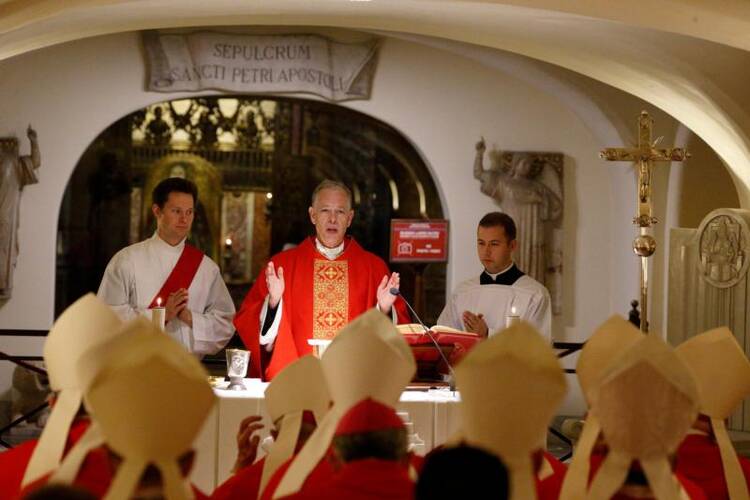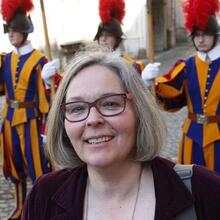VATICAN CITY (CNS) -- Celebrating Mass at the tomb of St. Peter with his fellow bishops from Washington, Oregon, Idaho, Montana and Alaska, Archbishop Alexander K. Sample of Portland asked them to consider the red vestments they were wearing.
Obviously, the liturgical color is chosen as a reminder that St. Peter died a martyr's death for his faith in Jesus, the archbishop said at the Mass Feb. 3.
But the Catholic Church also uses red when celebrating the gift of the Holy Spirit, he said, and it also is a universal symbol for the heart and, therefore, love.
Archbishop Sample was the principal celebrant and homilist at the Mass in the grotto of St. Peter's Basilica at the beginning of the bishops' weeklong visit "ad limina apostolorum" -- to the threshold of the apostles. The visits, required by canon law, are an opportunity for bishops to pray at the tombs of the apostles, meet the pope and discuss what is going on in their dioceses with the heads of Roman Curia departments.
Most of the bishops' days will be spent at the meetings with Curia officials, but, Archbishop Sample said, "really it is coming here to pray at the tombs of Sts. Peter and Paul that is the very reason for our visit," as well as to meet "with the successor of the blessed Apostle Peter," Pope Francis.
The archbishop said that 25 years ago, when he was studying canon law in Rome, he toured the excavations under St. Peter's Basilica for the first time. "I remember it like it was yesterday" when the seminarian leading the tour pointed to the niche containing the bones of St. Peter, "I immediately teared up. I became very emotional."
Christ himself entrusted the church to St. Peter and the apostles "to govern, to shepherd and to lead in his name," Archbishop Sample said.
"We wear red today because St. Peter gave his life in service of Christ and his church. He shed his blood here," the archbishop said. As successors of the apostles, "we too are called to lay down our lives for our Lord and for his people. We are to give our lives, to spend our lives, our blood, sweat and tears, in service of his people."
The red vestments also can symbolize the heart and the love a bishop must have for his people, he said. "What motivates us? What motivates us to get out of bed in the morning, to face the duties of being a shepherd in Christ's church?"
"It has to be love, devoid of any self-interest or ambition," the archbishop told his fellow bishops. "It must be love. Love for God with our whole heart, soul, mind and strength. Love for our people, wanting to share the good news of the mercy of Christ with them."
And, finally, he said, the red vestments are a reminder of the Holy Spirit, whom the bishops rely on for guidance each day.
None of the bishops "asked for this heavy office; we have been chosen," he said. "There's joy in knowing we do the will of our heavenly Father."









